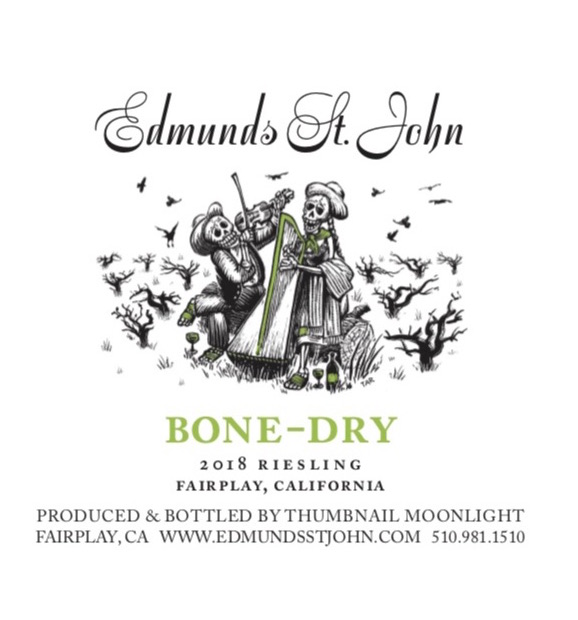Organolepticians #97 February 26, 2020
I made a Pinot Noir, back in 1989, and shot myself in the foot several times when I did. First of all, the grapes came from the Washington side of the Columbia River Gorge, which created the problem of only legally being entitled to use the designation “American” on the label when attempting to communicate something about the origin of the grapes. (Don’t ask—the rules governing many things, including wine labelling, have no connection to logic or other matters suggesting human intelligence.)
By 1989, we had begun to be known for wines we produced from Rhone-affiliated varieties, and Pinot Noir was pretty much viewed with so much skepticism that no one seemed to have much reason to be curious about what a Pinot Noir from Edmunds St John might have to offer. Partly for that reason, I was also advised, by a famous Santa Barbara County Pinot producer (who also boasted some talent in the preaching department) that I should blend in something to darken the color in order to make the wine easier to sell. He was persuasive enough that I did, as discreetly as I could. But before I did, I bottled a few gallons of it unblended to see how it might develop. (Kermit Lynch had advised me to bottle it in May of 1990, when he tasted it, and found it lovely. And I should have!)
When I released the Pinot for sale I put a modest price tag on it. It’s likely I might have sold lead balloons more easily; my inventory sat, until I dropped the price to a point where one of my retail supporters bought all of it, and sold it for $4.99 a bottle.
I made the wine because I’d tasted a wine from the same site, made by a friend who sells grapes to home winemakers, and we tasted a number of wines next to it, a couple of which were very nice minor Burgundies, and it compared beautifully. I felt that if I were ever to want to make a wine from Pinot Noir (and, secretly, EVERYONE did! Especially in those days, when the industry was still headed in the direction it was, when the only wines deemed worthy of anyone’s attention were those made from the varieties that produced the most expensive bottles in their countries of origin.) these were the grapes that could make something memorable. It didn’t occur to me that selling it might be a challenge. I bottled nearly 250 cases, as I recalled. Boom! Ouch!
Back then, the Riesling grape was still hailed by a number of the more thoughtful wine journalists as a contender for the distinction of best wine grape of them all, despite the fact that it had become notoriously hard to sell. For the most part, that seems to be unchanged. And yet, Riesling can, at its very best, produce some of the most sublime and breathtaking wines made anywhere, wines of startling beauty, wines that can move the drinker nearly to tears.
And what do you think happened when a couple of tons of Riesling became available in the Summer of 2018 from the Gwinllan Estate vineyard in Fair Play, for a very modest price? I couldn’t resist!
Twenty-nine years after the debacle with Pinot Noir, I thought: “this could be my last chance ever to make a Riesling! How could I pass it up?”
At least I didn’t cling to any illusions of making anything resembling a Riesling from either Germany or France, especially since Fair Play is a pretty warm area, such that much of the Gwinnlan Estate is planted to Cabernet Sauvignon (that other famous grape). I was intrigued with the decomposed granite soil there, and, given a reasonably mild harvest season, I thought it might be possible to make something in a California rendition of the variety that might be pleasing and fun to drink.
The Summer of 2018 was a fairly warm one; we picked the top half of the Riesling at Gwinnlan on the 31st of August, and the lower half on the day after Labor Day. The fruit was in beautiful condition, with low pH, and very good acidity.
Grapes were whole-cluster pressed, and fermented in stainless at 58 degrees, until completely dry, at which point the temperature was lowered and a bit of SO2 added to block malolactic.

The wine remained on primary lees until January, and was bottled Valentine’s Day, 2019. Alcohol is 11.8%.
After a year in bottle, it shows very pretty aromas: green apple, lime, and, if there’s a floral side to it, the closest I can get at this point is lavender; it’s very fresh, and energetic—the kind of wine people describe sometimes as nervous.
Flavors are likewise very fresh, very nicely delineated; there’s medium body, with lovely texture and length. There’s also a distinct salty note that I’ve never encountered in a Riesling from California before, and I like it quite a lot!
2018 Edmunds St John BONE-DRY RIESLING Fair Play, CA
We produced only 98 cases; the retail price is $16.00 per bottle, by the case, $170.00 (NET).
Also available:
| 2018 Bone-Jolly Gamay Noir | $23.00 per bottle |
| 2017 El Jaléo (Shake Ridge Ranch) | $29.00 per bottle |
| 2015 North Canyon Road Syrah | $35.00 per bottle |
Please email: edmundsstj@comcast.net to purchase!